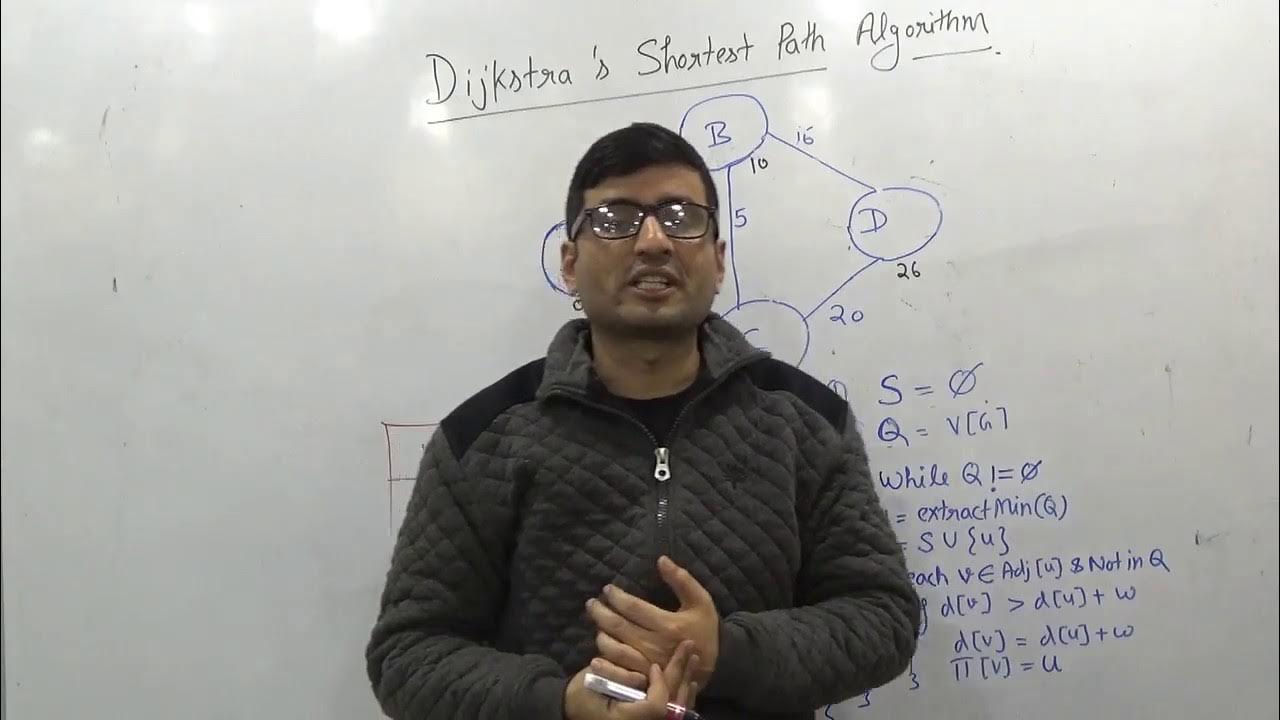How to Use Dijkstra's Algorithm
Summary
TLDRThis script explores how students can maximize their sleep by finding the shortest route to school using Dijkstra's algorithm. By representing the school's routes as a graph with nodes and edges, the algorithm helps determine the quickest path from home to school. The process involves calculating running values for each node, updating them as shorter paths are discovered, and eventually identifying the optimal route. This method allows students to save time and enjoy more rest, all without leaving the comfort of their bed.
Takeaways
- 😀 Students love sleep, but have to wake up early for class, sacrificing precious rest.
- 😀 To maximize sleep time, students need to find the shortest route to school.
- 😀 There are multiple routes to school, and finding the quickest one can be challenging.
- 😀 Instead of manually walking each route, we can use Dijkstra's algorithm to find the shortest path.
- 😀 Dijkstra's algorithm represents the map as a graph, with edges (roads) and nodes (junctions).
- 😀 Each edge in the graph has a value representing the time to walk from one node to another.
- 😀 The algorithm starts with the home node (starting point) and sets its running value to zero.
- 😀 The algorithm works by exploring adjacent nodes, updating running values based on the shortest time required to reach them.
- 😀 The running values are cumulative, meaning the total time is calculated by adding previous values plus the time of the current edge.
- 😀 The algorithm repeats until the school node (target) has the lowest running value, which gives us the shortest route.
- 😀 With the shortest route found, students can maximize their sleep by taking the fastest way to school.
Q & A
What is the primary goal of using Dijkstra's algorithm in the script?
-The primary goal is to find the shortest route from home to school, allowing students to maximize their sleep by walking the quickest path.
Why don't students time each walking route manually?
-Students don't time each route manually because it would require getting out of bed, and they prefer to stay comfortable while finding the shortest path.
How are the locations in the map represented in Dijkstra's algorithm?
-The map is represented as a graph with nodes (junctions) and edges (roads), where each edge has a value indicating the time it takes to walk from one node to another.
What is meant by a 'running value' in the context of Dijkstra's algorithm?
-A 'running value' refers to the total time it takes to reach a node from the starting point (home), including all the edges (paths) crossed to get there.
How does the algorithm determine which nodes have been visited?
-The algorithm marks a node as visited by setting its running value as 'fixed' once it has the lowest running value among the unvisited nodes.
What happens when a new node has a lower running value than an existing node?
-If a new node has a lower running value, the algorithm updates the running value for that node, indicating a more efficient route has been found.
At what point does the algorithm conclude that the shortest path has been found?
-The algorithm concludes when the target node (school) has the lowest running value, which indicates the shortest path from home.
What is the significance of the 'home' node in the algorithm?
-The 'home' node is the starting point of the journey, and it has a running value of zero because it takes no time to be at home.
Why is the shortest route important for students, according to the script?
-The shortest route is important because it allows students to maximize their sleep by minimizing the time spent walking to school.
How does Dijkstra's algorithm make finding the shortest path more efficient than trial and error?
-Dijkstra's algorithm ensures efficiency by systematically calculating the shortest path through nodes based on running values, eliminating the need for trial and error with time-consuming physical testing.
Outlines

This section is available to paid users only. Please upgrade to access this part.
Upgrade NowMindmap

This section is available to paid users only. Please upgrade to access this part.
Upgrade NowKeywords

This section is available to paid users only. Please upgrade to access this part.
Upgrade NowHighlights

This section is available to paid users only. Please upgrade to access this part.
Upgrade NowTranscripts

This section is available to paid users only. Please upgrade to access this part.
Upgrade Now5.0 / 5 (0 votes)





